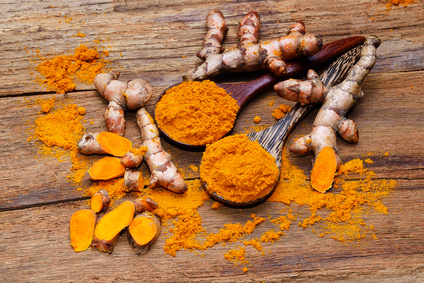

How does Turmeric fight Cancer and other diseases?
Posted on April 17, 2016 by Dr. G
Research done on plant based products for condition like cancer must determine if the intervention has preventive effects for cancer or chemotherapeutic benefits for cancer. Since 1987 over 1000 potential plant based agents have been identified as being a benefit to cancer and of those about 40 have moved to clinical trials. Keep in mind the motivation to study plant based agents is limited since intellectual property right and patents are not possible and therefore the profit motive is significantly less than drugs (it can cost up to $2.5 billion dollars to bring a drug through the FDA, clinical trials and marketing). It’s a miracle that any research is done on plant based agents at all.
Curcumin, found in the Indian spice Turmeric and gives it its characteristic color, is one of those few dozen that have been studied. This post will discuss curcumin in the context of cancer. Turmeric/curcumin is also beneficial and is being researched in autoimmunity, chronic pain and brain based conditions to name a few.
Chemo-preventive agents (agents that have been shown to prevent cancer), have 3 classifications.
- Anti-proliferative (prevent cancer cells from multiplying)
- Antioxidant. (prevents oxidation, the process where oxygen reacts with free electrons causing cellular damage)
- Carcinogen blocking. (preventing carcinogens we are exposed to, like chemicals in our environment, from attaching themselves to cellular components like the nucleus and DNA)
Curcumin belongs to all 3 of these categories because of its multiple mechanisms of action. Having multiple mechanisms of action is a quality that is unique to plant based agents. Drugs and pharmaceuticals usually have one single beneficial mechanism of action and many harmful mechanisms of action that result in a list of side effects a mile long. Think of the multiple mechanism of action of curcumin as multiple positive, desirable side effects.
It is estimated that tumors are mostly diagnosed at the age of 50, yet they are believed to begin at the age of 20, giving a decades long incubation period. Why so long? Its because 100’s of genes have to be modified in order to create cancer cells. This fact is very inconvenient for conventional cancer treatment because so much of the research and development for cancer treatment has gone to an increasingly specific single target mechanism of action leading to disappointment.
Conventional cancer treatment of course begins only after the diagnosis has been made, and rightfully so, however there could have been decades of benefit, if there was a safe, healthful intervention during the years prior to diagnosis. It turns out that there are many preventive measures that you can take, from the food you eat, the exercise you get and the “naturalization” of your environment, which is the focus of this website.
Pharmaceutical companies are now attempting to create multi-targeted therapies and drugs. Plant based therapies are always multi-targeted and are for the most part safe.
Conspiracy theory: “It’s not a conspiracy theory if it’s true”.
Epidemiological data reveal that overall cancer rates in places on the planet where turmeric is consumed in higher amounts is significantly lower than where turmeric is not used as a dietary staple. India is such a place.
In the US, men get 23X higher incidence of prostate cancer, 8-14X more melanoma, 10X more colorectal cancer, 9X more endometrial cancer, 7X more lung cancer, 8X more breast cancer, etc. This is not an east west issue either. The numbers for breast cancer and prostate cancer are even more dramatic when compared to China. It’s important to state that we are not talking about percentages, we are talking about magnitudes that exceed 1000% when we are talking about 10X more.
The epidemiological data is powerful because India makes up ⅙ of the world’s population. There are many factors in a population that influence the incidence of diseases, not merely the consumption of a single spice, however there is enough “smoke” here to investigate the likelihood of a “fire”.
Mechanism of action: Restoration of Innate Intelligence at the level of cellular DNA.
One of the several mechanisms of action Curcumin has in its anticancer effects is by restoring apoptosis. Apoptosis is also known as programmed cell death. We are made up of 10’s of trillions of cells, most of which are recycled and replaced every 100 days (3 months). The dismantling and rebuilding of our cells occurs at rate of about 100 billion cells per day. That’s a lot. When a cell is no longer able to function the way it was meant to when it was new, it is programmed (in the DNA) to destroy itself, so the immune system can clean up and recycle the debris. Cancer cells turn off that mechanism of cell self destruction once the cell no longer serves the greater purpose of the tissue or organ in which it resides.
Curcumin does this by sensitizing or up-regulating the cellular “death receptors” (specifically death receptor #5) as well as caspase #3 & #7 (also know as the “executioner enzyme”). I’m glad they got the team at Marvel comics to name these cellular components.
Aside: By the way, the raw materials used to replace these 100 billion cells per day is the food you eat. You literally are what you eat. Think about that the next time you eat something that is so processed it resembles nothing that grows out of the earth or walks across the earth.
Cancer cells do not develop resistance to the cancer killing effects of curcumin the way they do conventional chemotherapeutic agents.
So how much curcumin do you need? What is the chemotherapeutic dose and what is the chemo-preventive dose? What is the form in which you should take it? My answer is, “I don’t know”. A mentor and colleague of mine Dr. Christopher Turnpaugh, outside of Harrisburg PA, has a wonderful way to help us decide. As functional medicine providers we depend quite a bit on clinical experience in our practice and the clinical experience of our colleagues. The analogy goes like this, if you were to ask a fireman how much water does it take to put out a fire, his answer will be “it depends”. It depends on the size of the fire, a fire on your kitchen counter might require a glass of water to put out, a fire engulfing 75% of a building will require a whole lot more.
We can look at Indian populations and estimate their daily intake of Turmeric spice to be over 3 grams per day. Some of the turmeric spice may be dissolved into oils and fats used for cooking and some may be consumed in the dry form. Curcumin enters our bloodstream more effectively when it is dissolved in a fat, this is called liposomal. Circumin in its dry form, such as seen in capsule supplements, are not likely to be absorbed into the bloodstream for delivery to remote tissues like the brain, however that does not mean it is not useful in that form. The dry form of turmeric can coat the GI tract and dramatically impact inflammation both locally in the gut and systemically.
A quick read of many posts on this website will quickly emphasize the importance of the immune system in cancer and autoimmunity and curcumin will contribute to immune regulation.
A typical dose of medicinal turmeric or curcuminoids is 500 mg (½ gram). It is not uncommon to recommend 1 dose per day or 4, 6, 8 doses per day and beyond, depending on the presence of smoke, a small fire or bigger and bigger fires.
Please share any experiences you may have had clinically with turmeric or curcuminoids.
Thanks for reading!





